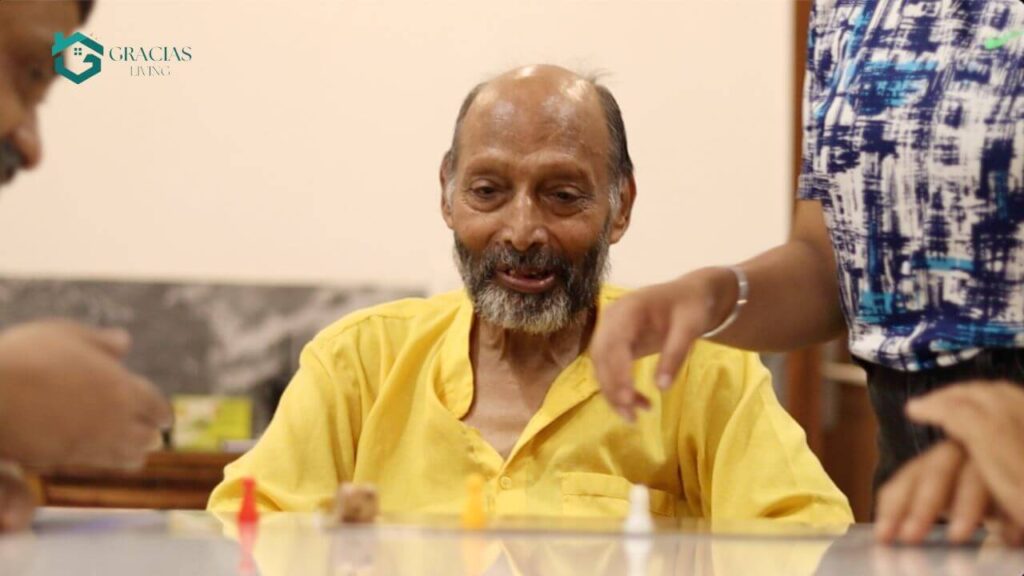Quick Summary of the article:
- Assisted living in India is growing rapidly in response to demographic changes favoring an aging population.
- Major Indian metropolitan areas host over 100 operational assisted living facilities, catering to the increasing demand.
- Despite being costly, these facilities provide high-quality medical care and services, meeting the needs of elderly residents effectively.
- Compared to Western countries, India’s average monthly cost of assisted living is approximately INR 1,25,000/-, making it a relatively affordable option.
- Indian assisted living facilities stand out for their premium care, modern infrastructure, and culturally sensitive environment, ensuring comfort and dignity for residents.
The assisted living sector in India is witnessing rapid growth, driven by an aging population and increasing demand for specialized senior care.
With the elderly population expected to reach 319 million by 2050, the market is projected to grow at a compound annual growth rate (CAGR) of around 17% from 2021 to 2026.
Over 100 facilities are now operational, primarily in metropolitan areas like Delhi NCR, Mumbai, Bangalore, Chennai, Pune, and Hyderabad.
This expansion reflects a broader recognition of the need for professional care that meets international standards, ensuring a better quality of life for seniors.

Factors Driving this growth and the professional services being offered by these facilities.
As the sector continues to grow and evolve, assisted living facilities in India are poised to play an increasingly important role in providing high-quality, compassionate care to seniors in India.
- Increasing Elderly Population: India is witnessing a significant demographic shift, with a growing elderly population. This demographic trend has created a pressing need for specialized care solutions tailored to the unique needs of seniors.
- Changing Family Dynamics: Traditional family structures are evolving, with smaller families and more dual-income households. As a result, there is a greater reliance on professional care services for elderly family members who may not have family members available to provide full-time care.
- Rising Awareness: There is a growing awareness among the Indian population about the importance of quality senior care. Families are increasingly seeking out professional care options that can provide the level of support and assistance their elderly loved ones need.
- Increased Investment: The assisted living sector in India is attracting significant investment from both domestic and international investors. This influx of capital is driving the rapid development of new facilities and the expansion of existing ones.
- Government Support: The Indian government has also taken steps to support the growth of the senior care sector. Initiatives such as the National Programme for the Health Care of the Elderly (NPHCE) aim to improve access to healthcare services for the elderly and promote healthy aging.
Why Assisted Living Facilities Are Expensive
India’s assisted living facilities have evolved to become reliable and trusted environments for senior care, offering services that meet international standards while catering to cultural nuances.
1. High-Quality Medical Care
Assisted living facilities provide comprehensive medical care with on-site medical staff, including doctors, nurses, and specialized caregivers.
These professionals offer round-the-clock supervision, regular health check-ups, and management of chronic conditions, which significantly contribute to the overall costs.
2. Professional Staffing
Employing trained and certified caregivers, along with support staff such as housekeeping, maintenance, and administrative personnel, ensures high standards of service.
The salaries and benefits of these professionals are a significant part of the operational expenses.
3. Modern Infrastructure and Amenities
Facilities are designed with senior-friendly features like ramps, elevators, handrails, and non-slip flooring to ensure safety and accessibility.
Additionally, providing comfortable living spaces with amenities such as air conditioning, entertainment options, and private bathrooms adds to the costs.

4. Comprehensive Services
Regular cleaning, laundry, and maintenance services are essential to maintain a hygienic and comfortable environment.
Nutritionally balanced meals, supervised by dieticians, cater to the dietary needs and preferences of residents, further driving up the costs.
5. Engagement and Wellness Programs
To promote holistic well-being, facilities offer a variety of recreational and social activities, fitness programs, and wellness workshops.
These programs require investment in equipment, specialized staff, and resources.
6. Safety and Security Measures
Ensuring the safety of residents involves employing 24/7 security personnel, installing CCTV surveillance, and implementing emergency response systems. These safety measures are crucial but also add to the operational expenses.
7. Technology Integration
Advanced health monitoring devices, telehealth services, and communication tools help in continuous health management and keeping residents connected with their families. Investing in such technologies is necessary but costly.
8. Regulatory Compliance
Facilities must adhere to regulatory standards, obtain necessary licenses and certifications, and undergo regular audits, which involve significant expenses.
9. Location and Real Estate Costs
Many facilities are located in prime urban areas where real estate prices are high. The costs of acquiring, maintaining, and upgrading these properties contribute to the overall expense.
10. Customized Care Plans
Developing individualized care plans tailored to each resident’s specific needs requires additional time, resources, and professional expertise, adding to the overall cost.
Comparative Costs of Assisted Living Facility in India
Let’s compare the costs of assisted living in India to those in developed countries:
| Country | Monthly Cost (In USD) |
| India | 2,100 |
| United States | 3,500 – 7,000 |
| United Kingdom | 3,200 – 7,000 |
| Canada | 2,600 – 4,600 |
| Australia | 2,000 – 5,000 |
- India: Premium facilities in India, costing around INR 1,75,000 per month (approximately USD 2,100), offer services comparable to international standards. Despite the lower cost, these facilities provide comprehensive care and amenities that meet the needs of residents at par with global standards.
- United States: In the U.S., assisted living facilities can cost anywhere from USD 3,500 to USD 7,000 per month. The higher costs are attributed to factors such as the high standard of living, advanced medical technology, and extensive regulatory requirements.
- United Kingdom: In the U.K., costs range from GBP 2,500 to GBP 5,500 per month. While the costs are slightly lower than in the U.S., they remain relatively high due to the quality of care, stringent regulations, and the overall cost of living in the country.
- Canada: In Canada, the monthly costs for assisted living range from CAD 3,500 to CAD 6,000. Similar to the U.S. and the U.K., the costs are influenced by the high standard of care, quality of facilities, and the cost of living.
- Australia: Assisted living in Australia can cost between AUD 3,000 to AUD 7,000 per month. The relatively high costs are due to the country’s high standard of living, quality healthcare, and stringent safety regulations.
Can NRIs Trust the Care in Assisted Living Facilities in India?
For Non-Resident Indians (NRIs) looking to ensure the well-being of their elderly relatives back home, choosing the right assisted living facility is a crucial decision.
The good news is that India’s assisted living sector has made significant strides in recent years, evolving to meet international standards of care and comfort. Here’s why NRIs can trust the care provided by these facilities.

Reasons NRIs Can Trust Assisted Living Facilities in India
- Premium Standards of Care: Many assisted living facilities in India are designed and managed to meet international standards, offering high-quality medical and personal care that is on par with global benchmarks.
- Professional Expertise: Facilities employ trained professionals including doctors, nurses, caregivers, and therapists who specialize in geriatric care, ensuring that residents receive expert attention tailored to their specific needs.
- Modern Infrastructure: The infrastructure of these facilities includes state-of-the-art medical equipment, accessibility features such as ramps and elevators, and aesthetically pleasing living spaces that enhance comfort and safety.
- Personalized Care Plans: Assisted living facilities in India emphasize individualized care plans that cater to the unique health and lifestyle requirements of each resident, ensuring personalized care and support.
- Comprehensive Medical Services: From routine health check-ups to emergency medical care and management of chronic conditions, these facilities provide comprehensive medical services, often with partnerships with nearby hospitals for specialized treatments.
- Engagement and Wellness Programs: To promote holistic well-being, facilities offer a range of engagement activities, wellness programs, and recreational options that keep residents physically active and mentally stimulated.
- Transparent Communication: Facilities maintain transparent and regular communication with family members, providing updates on the resident’s health and well-being, which is particularly important for NRIs who cannot visit frequently.
- Safety and Security: Advanced safety measures, including 24/7 security personnel, CCTV surveillance, emergency response systems, and secure entry and exit points, ensure a safe living environment for residents.
- Cost-Effective Solutions: Compared to similar facilities abroad, assisted living in India can be more cost-effective, providing high-quality care at a fraction of the cost, which is beneficial for NRIs managing expenses across countries.
- Cultural Comfort: Facilities in India are well-versed in the cultural preferences and needs of Indian seniors, providing familiar food, festivals, and cultural activities that make residents feel at home.
Why Select Our Community to provide seniors with care?
When it comes to choosing between Gracias Living and basic care, one is choosing a model which is nurse-centred and focuses on providing care in a comprehensive manner.
Our facilities offer medical care under professional attention, 24/7 on-site services, hence giving prompt attention to any emergency, and this saves much more than having interim staff at home to attend to this. It has elderly-friendly facilities, such as emergency call buttons, ramps, and non-slip floors, which were planned to the ground level to avoid accidents and harm from falls.
It is not only about safety; our product is about an interactive social life cycle. The residents are involved in daily structured activities, therapy and community meals, each of which actively discourages the loneliness and depressive state of mind that most at-home interactions lead to.
Moreover, this magnitude of information disclosure and online feedback is essential to families, particularly those that are internationally based, and builds confidence and the feeling that they are entirely sure their loved one is in great health, obtaining the top and reliable care.
Conclusion
The growth of senior living in india and assisted living facilities in India signifies a substantial step forward in elderly care and well-being.
This sector is rapidly expanding, driven by factors such as the steadily increasing elderly population and a heightened awareness of the significance of professional senior care.
By providing a wide range of professional services, these facilities actively cater to the essential needs of their residents, thereby enhancing their quality of life in a beautiful and supportive environment.
This growth not only reflects a positive trend in the way society values its elderly but also highlights the commitment of these facilities to ensure that seniors receive the care and attention they deserve as they enter their golden years.
Frequently asked questions
1. Does assisted living increase the life expectancy of people?
Research has indicated that the overall care, isolation minimisation, regular nutrition and immediate medical care provided by assisted living may be rehabilitative to the health and may also increase life span and life quality.
2. What is admittedly one of the largest disadvantages of assisted living?
Its greatest weakness is usually the very expensive pricing because a single monthly fee provides a place to stay, twenty-four-seven staffing, food and facilities. This would prove to be prohibitive to other families, particularly in situations where there is no access to long-term care insurance.
3. Why are assisted living facilities increasing in India?
Increase is forced by the growing nature of the ageing population in India, the fragmentation of traditional joint families, ever-rising cases of professional migration, as well as an awareness on the part of families of the necessity to access professional, safe and social care of the seniors.
4. What are the modern assisted living facilities’ services?
Contemporary facilities offer help with all the activities of daily living (ADLs), medications, appointments with physicians, dietary meals under dietetic guidance, physical therapy directly on-site, and a program of extensive social and wellness activities.
5. What does the future of assisted living in India promise?
Its future is twofold: minimal changes in large cities, more use of technology (such as AI in healthcare), and moving to the establishment of high-quality, culturally sensitive care that meets international standards.




